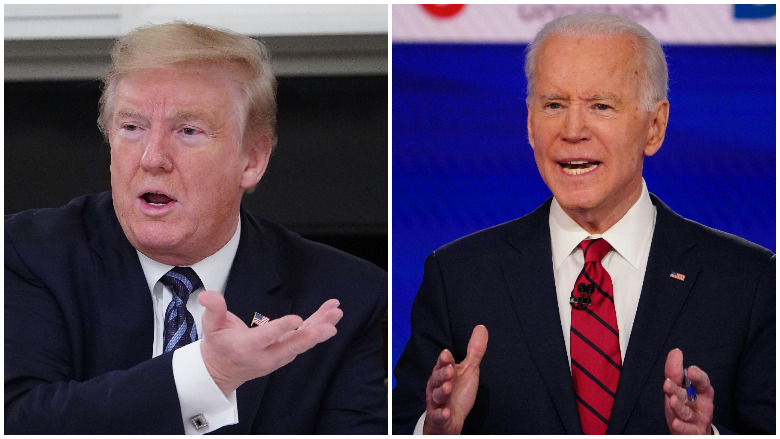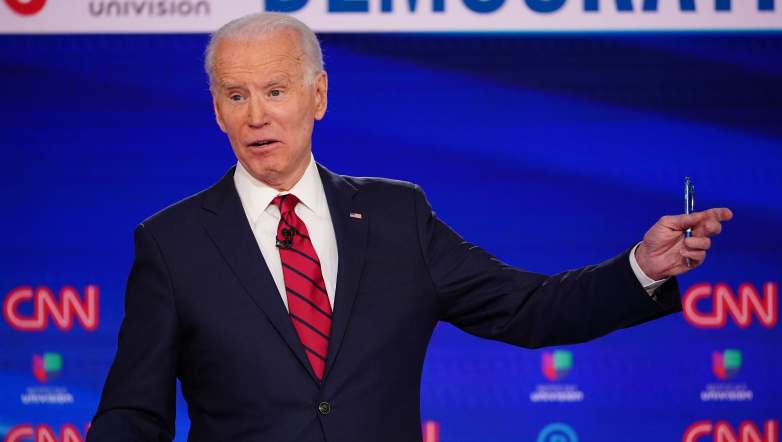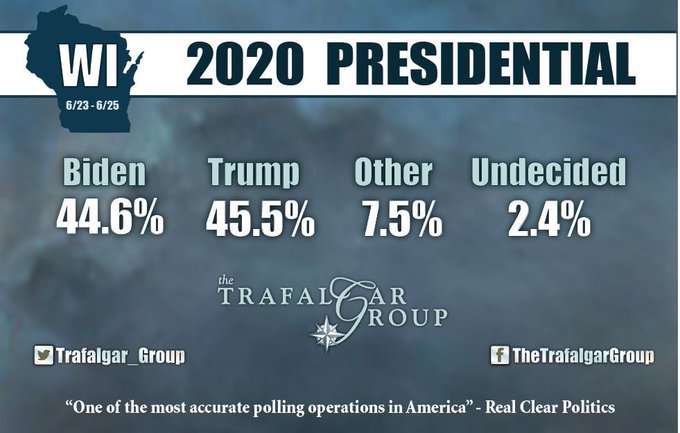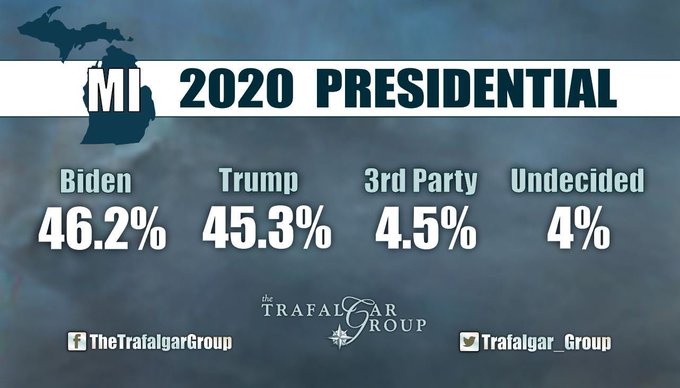
Getty Trump vs. Biden: A new battleground poll shows a Trump lead.
A new Wisconsin poll shows President Donald Trump with a small lead over Democratic challenger Joe Biden in the crucial battleground state. The poll is by Trafalgar Group, a pollster that correctly predicted Trump would win the Electoral College in 2016. Trafalgar Group had the only polls showing Trump winning the battleground states of Pennsylvania and Michigan in the last election. The group also correctly predicted that Trump would win North Carolina and Florida in 2016. Most other pollsters got 2016 wrong.
The Trafalgar Group’s 2020 Wisconsin and Michigan polls are outliers this year too, as most other polls show Joe Biden breaking out with significant leads over the president. In national polls, 15 polls since June 5 have shown Biden ahead of Trump. You can see a roundup of recent polls from FiveThirtyEight here.
June 2020 polls by Trafalgar show both Wisconsin and Michigan to be basically dead heats, within the margin of error. The pollster has Trump up by 1 percentage point in Wisconsin, and Biden up by 1 percentage point in Michigan. That’s not what other polls are showing. The Center for Politics’ Alan I. Abramowitz points out that “a close analysis of national polling in 2016 and 2020 based on data compiled by RealClearPolitics indicates that Biden’s lead over Trump has been only slightly larger than Clinton’s lead over Trump between January and early June. However, Biden’s lead has been much more consistent.”
Trafalgar Group is a polling organization that suspected all Trump supporters weren’t willing to be honest with pollsters in 2016 about whether they supported Trump. It’s called the social desirability effect, whereby voters don’t feel it’s socially acceptable to admit voting for Trump, but they will do so in private. So the pollsters started asking people who they thought their neighbors would vote for and determined the numbers were different. The firm, which is based out of Atlanta, adjusted its numbers to account for this factor in 2016. “On a live poll, the deviation was that Trump was understated probably 6%-7%, and on an automatic poll it was probably understated 3%-4%,” Trafalgar’s Robert Cahaly told TIPP Online in 2016.
RealClearPolitics reported in 2018 that Trafalgar’s model in 2016 also factored in “a unique method that sought to measure support from voters who’d been ‘inactive’ in recent election cycles.” The site reports that Trafalgar also correctly predicted Republican Ron DeSantis’s Florida gubernatorial victory, which other polls missed, as well as Senate races in multiple states, after the 2016 presidential election. “The pollster believes his method and methodology will be more valuable than ever as low voter response rates and social desirability bias continue to present challenges to all pollsters in the future,” the site reported. Trafalgar didn’t poll Wisconsin in 2016.
Heavy spoke at lengthy with Cahaly about the 2020 election on June 29, 2020. He told Heavy that he believes Trump will win Wisconsin by about 2 percentage points but that the general election and Michigan are too close to call. Of course, the election is months away, which can be a lifetime in politics, and, again, his perspective doesn’t match other polling.
Cahaly said the firm is currently polling in Florida and Pennsylvania but doesn’t have those results yet. He believes the social desirability effect is even more pronounced today. He also believes that other polls are in error, again, because they’re using outmoded models that don’t tease out irregular voters or those who are reluctant to admit their private Trump support. You can read more about Cahaly’s comments later in this article.
Trafalgar is not without critics. The New York Times reported that Trafalgar “does not disclose its methods, and is considered far too shadowy by other pollsters to be taken seriously. Mostly, they dismiss it as an outlier.” The Times noted that Trafalgar’s Robert Cahaly in 2016 even called the “exact number of Electoral College votes” received by the candidates. But concerns center around funding and methods transparency.
The Times noted that Trafalgar releases “almost no real explanation of his polling methodology.” You can see the group’s methodology page here. Another expert cited by the Times dispute Cahaly’s belief that there are shy Trump voters unwilling to admit their support for the president. The Times also reported that Trafalgar’s clients are mostly Republican and conservative, and Cahaly has “not reliably revealed” when polls are paid by “partisan interest,” which is a defiance of industry standard.
“It is wildly inappropriate not to tell me, not only what modes you use to draw your sample, but how specifically you did it,” Josh Pasek, a professor of communications, data and political science at the University of Michigan, told The Times. “If somebody’s not transparent you can generally assume they’re crap.”
What do the 2020 Trafalgar polls show for key battleground states?
In Wisconsin, Trafalgar has Trump up 45.5% to 44.6%. That’s in the margin of error of 3.04%. That’s a very different result from the other recent polls out of Wisconsin. They showed Biden up by 8 percentage points (Marquette poll); Biden up by 4 (CNBC/Change Research); Biden up by 11 (New York Times/Siena); and Biden up by 9 (Fox News.) As of June 29, the RealClearPolitics polling average for Wisconsin showed Biden’s spread at 6.2% over Trump.
In Michigan, Trafalgar’s poll for June 2020 showed Biden with 46.2% and Trump with 45.3%. The margin of error was 2.95%. The RealClearPolitics polling average for Michigan shows Biden up 8.6%. Recent polls showed him with commanding leads, although, one, CNBC/Change Research, has his lead at only 2%. As for others, the New York Times/Siena poll for Michigan had Biden up by 11 points; TIPP by 13 points; and EPIC-MRA by 16 points.
Trafalgar doesn’t have a recent poll for Pennsylvania, the third in the trifecta of rust-belt states that helped give Trump the 2016 election.
As noted, Trafalgar, again, stands pretty much alone. A slew of other polls have shown strong support for Biden, including in comparison to Hillary Clinton’s polling in 2016. The Center for Politics notes:
Joe Biden has held an average lead of 5.9 points over Donald Trump in 72 national polls between January and early June. Hillary Clinton held an average lead of only 4.7 points in 221 national polls between January and early November, but her average lead was 5.7 points in 44 polls between January and early June. However, Biden’s lead has varied very little from month to month, ranging from 5.0 points in January to 7.7 points thus far in June. In contrast, Clinton’s lead varied from only 2.4 points in July to 10 points in March.
In 2016, that center’s author, Abramowitz, a political science professor at Emory University, saw Trump’s strength when others didn’t, but his model studies the popular vote, and he predicted Trump would win the popular vote. Clinton ended up winning the popular vote, while Trump won the electoral college.
In May 2020, Abramowitz wrote that Biden was favored by recent battleground state polling and added, “The recent 2020 polling results correlate much more strongly with the 2016 election results than with the final 2016 polling results.” He believes this “suggests that pollsters have adjusted their sampling and weighting procedures to correct for some of the problems that occurred in 2016 in light of the 2016 results.” He determined Biden was doing better in swing state polls than Clinton did.
However, Cahaly doesn’t believe that many pollsters have learned the lessons of 2016. Time will tell, of course.
Here’s what the polls show specifically in the battleground states of Wisconsin and Michigan:
Trafalgar Group Poll – Wisconsin [June 23-June 25]
| Donald Trump | 45.5% |
| Joe Biden | 44.6% |
| Other Candidates | 7.5% |
| Undecided | 2.4% |
Trafalgar Group Poll – Michigan [June 16-June 18]
| Joe Biden | 46.2% |
| Donald Trump | 45.3% |
| Third Party Candidate | 4.5% |
| Undecided | 4% |
Trafalgar Predicts a Very Close Race Overall Between Biden & Trump

Donald Trump.
In the interview, Cahaly told Heavy that the firm has changed its methodology somewhat for 2020 but wasn’t going to reveal all of that information until the election was over. However, he said that he believes most other polls are inaccurate, calling them “Pony Express polling that most of the other groups use these days.”
For example, he believes that calling a small number of households’ landlines with long questionnaires isn’t very effective because “I don’t think average people take those polls.” He said such polling tends to over represent “people who care too much on both sides. It over represents the people who have strong opinions. The people in the middle don’t have time to fool with it.”
He believes that people are more hesitant to tell pollsters who they’re voting for today than they were in 2016 because we live in a society in which “people get penalized for their opinions. They’re not going to tell you what they think of the protests, of the riots, of statues. It’s significantly worse, especially with groups that it would be out of character for them to say so.” For example, he feels there is more minority and college-educated female support for Trump than people will admit.
He said Trafalgar does do some phone calls, but “we compensate for that in the way we ask the questions,” and the firm also does a lot of digital, text, email, and other methods. “We guarantee anonymity. We’re not working for a campaign or party.”
He said the firm has ways of getting at the social desirability effect that he wouldn’t detail. He said he believes that the 7.5 percent in the Wisconsin poll listed as supporting a third-party candidate actually contains a “few percent for Trump in there.” He called those shy or “reluctant voters.” He believed there would have been a social desirability effect with Bernie Sanders too but not with Biden.
He added that people don’t trust pollsters. “People don’t want to be on a list,” he said.
“I can tell you looking internally I think there is a significant amount of people for Trump” in the undecided or third-party category, he said.
Asked whether he thinks Trump will win Wisconsin, he said, “I absolutely do. I think he will win by more than 2 points.”
He said the past few months have “not been Trump’s high point,” but he believes that some “reluctant Trump voters” who “don’t like his style, a couple things he said” will move into Trump’s column because they are upset by “the cancel culture” and national unrest. He believes that, in 2016, Trump received fewer Republican votes “than anyone will ever know” but did better among groups like independents and minorities than people think. Cahaly believes Trump has growing minority support.
Asked whether he thinks Trump will win Michigan, he said, “I don’t know. It will be closer than Wisconsin.”
He said the biggest risk for Democrats is “overconfidence.”
Cahaly said the firm works hard to identify a pool of voters who aren’t consistent voters. Perhaps they voted provisionally. They created a “fingerprint of what a Trump voter looked like,” and matched it to the characteristics of voters who “hadn’t voted in many years” to get them back “in the pool” of those who might be sampled. He said that he doesn’t believe the firm undersampled certain demographic groups, like ethnic minorities, because they are likely included in the unidentified demographic category as a lot of states don’t collect that information about voters.
He thinks that voters “like Joe Biden” generally but that some are concerned he’s not the one who will be “running the show.”
Asked if he thought Trump would win the election, Cahaly said, “right now it’s extremely close” and that some of the group’s models show him winning by a 4-5 electoral vote margin, and some show him losing by the same. He thinks one candidate will end up with electoral votes in the 270s and the other in the 260s and called it “very, very close.”
He insisted that the “pony express polling model” that he believes others use “is wrong” and said that the people who got it wrong in 2016 “refuse to change. They need to get into the real world a bit.”
He cautioned that a lot could change between now and the November election. He said that some critics have claimed the firm uses automated polling but insisted that is “absolutely not true. We use technology most of these guys don’t understand.”
He disputed the label that Trafalgar is a Republican-leaning pollster, saying that, while he is a Republican, everyone at the firm isn’t, and that Republicans have been angry at the firm’s predictions in some races – such as when the firm believed it was “impossible for Republicans to beat Joe Manchin” or felt John James could not win Michigan. He insisted their data is “more tied to the truth. We’re not going to be influenced.”
What Do Other Models Show?

GettyJoe Biden
A few other models – some of them created by professors – also correctly estimated Trump’s strength in 2016. What do they show now?
Primary Model.com predicted the 2016 election right. Helmut Norpoth, a Stonybrook University political science professor, wrote before the 2016 election, “It is 87% to 99% certain that Donald Trump will win the presidential election on November 8, 2016; 87% if running against Hillary Clinton, 99% if against Bernie Sanders.” The model looks at primary polling but also the election cycle.
Norpoth wrote, “What favors the GOP in 2016 as well, no matter if Trump is the nominee or any other Republican, is the cycle of presidential elections. After two terms of Democrat Barack Obama in the White House the electoral pendulum is poised to swing to the GOP this year.”
What is he saying now? Primary Model.com says: “The Coronavirus outbreak appears not to have damaged Trump’s re-election prospects…In fact, the battle against the virus may help his re-election prospects by casting Trump as a wartime president, as happened with other presidents.”
His model is predicting a 91% Trump victory. He writes, “The Primary Model gives President Trump a 91% chance of winning a possible match-up with Democrat Joe Biden in November, based on primary performance in New Hampshire and South Carolina, plus the first-term electoral benefit. Trump would get 362 electoral votes, Biden 176.”
However, another academic model, by Professor Ray Fair, isn’t as enthusiastic for Trump.
He told Heavy.com in an email on June 29, 2020, “Given likely growth rates before the pandemic, the equation was predicting a Trump victory. Given likely growth rates now, the equation is predicting a Democratic victory.”
His forecasting is pretty hard to interpret for a person not familiar with macroeconomics, but he predicted Clinton would get 44% of the final vote, with a Trump victory. Fair is an economics professor at Yale University. His predictions are based on macroeconomic modeling.
Here is a page explaining his model. It includes a link where you can calculate your own projections using predicted growth rates. In April 2020, he cautioned,
I did not make an economic forecast with my US model this time because the model has nothing to say about the effects of pandemics. I could try to subjectively constant adjust the estimated equations, but this would only be guessing. So I am going to let the user decide what values of G and P to use. The per capita growth rate in the first quarter of 2020 was -5.2 percent at an annual rate. If your guess (annual rates) is -10 percent in the second quarter and -5 percent in the third quarter, then G is (1-.052)(1-.10)(1-.05) raised to the 1/3 power and then subtract 1, which is -6.76 percent. If you use the link “Compute your own prediction,” this is done for you, where you need to give as inputs the per capita growth rates at annual rates for the second and third quarters. The value of P through the first quarter of 2020 is 1.9 percent, so using 1.9 will likely be fairly close to the actual. Also note when choosing your estimates of per capita growth rates that population is growing at about 0.5 percent per year at an annual rate. So subtract 0.5 from estimates of non per capita growth rates.
IBD-TIPP was another poll that fared well in 2016. Of the 10 most recent polls in the Huffington Post database before election day 2016, this one came closest. It predicted right before the election that Clinton was up by 1, the closest in national polls. The poll queried respondents about their enthusiasm, and then factors this into the results. The 2016 poll had Trump up 1.6% in a four-way race on election day. Investors Business Daily noted, “Not one other national poll had Trump winning in four-way polls. In fact, they all had Clinton winning by 3 or more points.”
What’s that poll showing now? On June 4, an IBD-TIPP poll showed “Joe Biden leads Donald Trump 45%-42% among registered voters, after the two candidates were tied at 43% in May’s poll.” The poll found that “President Trump’s coronavirus crisis bounce in popularity collapsed over the past month…Trump’s job approval is at the lowest point in two years, while Americans now give him negative marks on handling the Covid-19 pandemic.”
READ NEXT: Why the Polls Were So Wrong in 2016

